
Dear Members:
Today, less than one percent of those who are treated with radiation for cancer and other diseases receive proton therapy. The others are receiving conventional X-ray "photon" radiation.
Those who understand proton technology and the benefits of proton therapy, feel that at least 20 percent of those receiving conventional radiation would have a much better result with proton therapy. Some feel that as much as 50 percent would have better outcomes because protons do a much better job of hitting the target and leaving healthy tissue undamaged. That means that even with 15 proton centers in the U.S., treating less than one percent of the radiotherapy patients, the proton market could be more than 20 times larger than it is today. And with research underway at all proton centers to reduce treatment cost and treat both new tumor sites, as well as certain non-cancerous diseases, the market for protons is even greater. So, hold onto your hats"the explosive growth of proton therapy is just beginning.
Dr. James Slater, the pioneer of proton therapy, predicted 25 years ago that someday there will be 100 proton centers in the U.S. History will someday prove him right. Dr. Slater truly is a genius. To this day he is exploring applications for the proton particle that are beyond our comprehension. As our opening quote suggests, he was and is ahead of his time.
We have another jam-packed BOB Tales for you this month starting with a study that supports the efficacy of proton therapy for treating prostate cancer. Also, new developments with prostate cancer testing and diagnosis are discussed along with other news relating to preventing, diagnosing, and treating prostate cancer.
We have an important health tip that could literally save lives. Our toughest brain teaser to date stumped all but one of our members last month. And I know that this month's humor section will put a smile on your face.
I had the privilege of speaking at a Wednesday night meeting at Loma Linda last month. I used the opportunity to announce our 7,000th member. It's hard to believe that our organization is almost 14 years old and we have 7,000 members representing 17 proton centers around the world in 35 countries. We must be doing something right.
On a more serious note, I have a request. I have always been a strong believer in the healing power of prayer. However I find that now my own faith is being severely tested. Two months ago, my daughter Deb's husband, Mark, was diagnosed with pancreatic neuroendocrine carcinoma. He is currently undergoing intensive medical treatment in Boston. We've been asking our family, friends, and acquaintances for their prayers. I'd also like to request prayers from our friends in the BOB. Please remember Mark, Deb, and their daughter, Gemma, in your prayers, asking God for healing, for His will to be done in their lives, and to help them through this most difficult time.
Bob Marckini
To print the BOB Tales newsletter or view the newsletter with a larger font size, click here for the PDF file.
in this issue
- Five year study shows 99 percent disease control for low and intermediate risk cancer
- Higher doses and fewer treatments"hypo-fractionation is showing great promise
- Testing inaccuracies cast doubts on active surveillance
- Exciting developments in prostate cancer testing and diagnosis
- Johns Hopkins Health Alert provides one more reason for choosing proton
- Sleep problems tied to prostate cancer risk
- One member reports: Lessons learned at Loma Linda
- Be careful of selenium supplements
- Loma Linda visit: Golf, Advisory Council, and Wednesday night meeting
- Award presented to 7000th BOB member
- How to block unwanted phone calls
- New CPR: Maybe our most important health tip ever
Membership: 7,015

We added 40 new members last month. We have members from all US states and 35 countries representing all operating proton centers in the U.S. as well as three proton centers in Europe and Asia.
News Report
New Five-Year Study Confirms Proton's Efficacy
The following was abstracted from the March 19, 2014 issue of the UFPTI Precision Newsletter.
Physicians and researchers at the UF Proton Therapy institute followed hundreds of prostate cancer patients who were treated for early, intermediate, and advanced prostate cancer. The study found that at five years, 99 percent of men with early and intermediate stage prostate cancer were disease-free, while 76 percent of the men with advanced cancer were disease-free.
Following is a table presented with the report with footnotes referencing sources of information used:
| Decision Points | Proton Therapy for Prostate Cancer | Surgery for Prostate Cancer |
| Disease Control* | 99%–76%1 | 84%–60%2,3 |
| Treatment | ||
| Major complication rate | 1%1** | 28.6%4 |
| Invasive Procedure | No | Yes |
| Long Recovery Time | No | Yes |
| Fatigue | No | Yes |
| 30-day mortality rate | 0% | 0.5%4 |
| Rehospitalization rate | 0% (N/A) | 4.5%4 |
| Side Effects Percent of patients who experience a change post treatment |
||
| Incontinence | 0%1 | 6%–30%4 |
| Impotence | 34%1 | 60%–80%1 |
| Inguinal hernia | 0% (N/A) | 7%–21%4 |
| Fecal Incontinence | 1.4%1** | 17%–32%5 |
* Disease control is defined as freedom from clinical or PSA progression at five years.
**1% per Common Terminology Criteria for Adverse Events (CTCAE) v4.0; 5.3% per CTCAE v3.0
1.Mendenhall, NP et al. Five-Year Outcomes from 3 Prospective Trials of Image-Guided Proton Therapy for Prostate Cancer. Int J Radiation Oncol Biol Phys 2014 March; 88(3):596-602.
2.Han, M et al. Long-Term Biochemical Disease-Free and Cancer-Specific Survival Following Anatomic Radical Retropubic Prostatectomy: The 15-Year Johns Hopkins Experience. Urol Clin North Am 2001 Aug; 28(3):555-65.
3.Qi, P et al. Long-Term Oncological Outcomes of Men Undergoing Radical Prostatectomy With Preoperative Prostate-Specific Antigen <2.5 ng/ml and 2.5-4 ng/ml. Urol Oncol 2013 Nov; 31(8):1527-32.
4.Treatment Option Overview for Prostate Cancer, Health Professional Version, http://www.cancer.gov/cancertopics/pdq/treatment/prostate/HealthProfessional/page3#Section_2223. Retrieved Aug. 28, 2013.
5.Bishoff JT et al. Incidence of fecal and urinary incontinence following radical perineal and retropubic prostatectomy in a national population. J Urol 160 (2): 454-8, 1998.
Once again, considering the degree of disease control with protons and the significantly lower level of side-effects and resulting quality of life, the efficacy of proton therapy is clearly demonstrated.
Hypo-fractionation: Perspective on an Ongoing Avenue of Clinical Research
From the LLUMC Proton Charity Invitational Brochure
Proton radiation therapy is well known for its ability to conform the radiation dose to the needed treatment volume and to greatly reduce"and often eliminate"dose to surrounding normal tissues and structures. The ability to spare normal tissue is at the heart of the reasons Dr. James M. Slater began investigating proton therapy in the late 1960s: He knew that the serious side effects he was seeing in patients being treated in those days owed solely to excessive radiation to normal tissues. There had to be a better way, and he thought proton therapy would be that way. Clinical results reported at Loma Linda since proton therapy began there in 1990 have borne this out: Side effects were reduced in frequency and severity, even when higher total doses were given.
What may not be so well known is that the same physical properties that produced these benefits could be used to produce others. One example of this is hypofractionation.
Hypofractionation simply means fewer "hypo" fractions. Each individual proton treatment is called a fraction; these are added up until the entire treatment dose is delivered. In hypofractionation there are fewer fractions to add up, but each is larger. The idea is an old one: Hypofractionation with conventional photon radiotherapy has often been tried, but it has had limited success because larger photon doses to target volumes necessarily result in larger doses to normal tissues as well. Side effects increase as a result.
With protons, however, larger fractions can be delivered while still keeping the doses to normal tissues low. This owes to the inherent physical properties of the proton beam: lateral scatter is reduced as the beam of heavy particles "protons" passes through tissue, and the beam can be stopped where the physician desires "the "Bragg Peak"", resulting in low or no dose beyond the path of the beam.
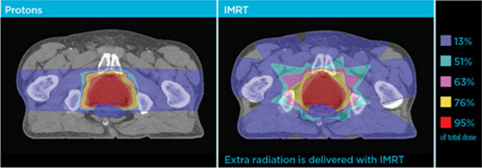
Physicians at Loma Linda University Medical Center began using hypofractionated protons two decades ago. Studies done since that time, led by Dr. David A. Bush of the Department of Radiation Medicine, have shown that high total doses can be delivered to tumor volumes in the lung, liver, and breast, using fewer fractions. Overall treatment times have been shortened to half or less of the times needed to deliver conventional photon radiation. Control rates have remained consistent and side effects have remained low. A similar study is now ongoing for patients with prostate cancer; thus far, results continue to be promising. The department anticipates that hypofractionated treatments will become routine in the near future. Indeed, this is already the case with medically inoperable non-small-cell lung cancers.
Hypofractionation is important for several reasons. Reducing overall treatment times is attractive to patients, and permits more patients to be treated per day. It can also reduce the cost of treatment because fewer hours of therapists' time, beam use, and use of ancillary services are needed.
Dr. Jerry D. Slater, Chair of the Department of Radiation Medicine, often notes that proton therapy is still a young discipline. The potential of protons is still being tapped. Clinical research programs at Loma Linda University Medical Center are aimed at exploiting that potential as fully as possible, and hypofractionation is one example of that clinical research in action.
Hypofractionation clinical trials are also underway at four other proton treatment centers in the U.S.
Testing Inaccuracies Cast Doubts on Active Surveillance Strategy
According to an article in the British Journal of Cancer, researchers are suggesting that prostate cancer in some men is being allowed to progress to a dangerous stage because tests are not accurate enough. In their study, more than half the men they followed whose tumors were initially classified as slow-growing and confined to the prostate turned out to have a more serious form of the disease.
These findings cast doubt on the growing use of "active surveillance" for dealing with prostate cancer.
Urological surgeon Dr. Greg Shaw, from the Cancer Research UK Cambridge Institute said, "Our results show that the severity of up to half of men's prostate cancers may be underestimated when relying on tests before they have surgery. Whilst active surveillance would seem to be a safe approach for some men, nearly a third will end up needing surgery or radiotherapy within five years."
Coincidentally, advances in prostate cancer testing reported in the following article may help to resolve this dilemma.
Recent Advances in Prostate Cancer Testing and Diagnosis
Two new developments relating to diagnosis of early-stage prostate cancer have become available and should prove be very helpful in deciding whether to consider immediate treatment, or to instead opt for active surveillance.
Multiparametric MRI-guided Biopsy
Too often, men who have had a rising PSA have been biopsied using only ultrasound guidance and nothing was found. But when their PSA is rechecked, they discover that it has risen, leading to additional biopsies. Sometimes this process is repeated multiple times.
Now there's a much improved method for finding the tumor"s" within the prostate using multiparametric MRI technology. This new approach is available at most major medical centers and it is sometimes accompanied by mpMRI-guided biopsy capabilities, allowing direct visualization of the prostate during the MRI analysis so that the physician can precisely target the regions of concern within the prostate. For more information, search "mpMRI prostate" on the Web or ask your physician.
Genomic Prostate Score
Once the biopsy has been performed and a positive sample obtained, if it's Gleason 6 or at most, 3+4 = 7, the sample"s" can be analyzed to determine the aggressiveness of the tumor"s", based upon a genomic analysis performed by the Genomic Health Company. A value called the Genomic Prostate Score "GPS" is produced. This indicates whether the tumor is more or less 'favorable.' For more information on this, go to www.myprostatecancertreatment.org.
These new methods should help greatly in detecting early-stage tumors and providing an informed basis for the important decision of whether to consider active surveillance.
spotlight on members
Lessons Learned at Loma Linda
Bill Vancil once took a job as a one-dollar-an-hour radio announcer, and later went on to become executive vice-president, general manager, and part owner of five mid-west radio stations. He later switched careers and started a graphic design firm. When diagnosed with prostate cancer, he did his homework, chose proton therapy, and had a wonderful outcome. Bill documented his prostate cancer journey by authoring a book, Don't Fear the Big Dogs. His next writing endeavor was a children's book, Roy and Kitty, a photographic story of the love affair between two of his best friends, his dog, Roy and his cat, Kitty.
Bill has done much to support proton therapy and Loma Linda. He serves on the Proton Advisory Council, and is on the proton patient reference list helping many newly diagnosed men learn about proton therapy for prostate cancer. He recently drafted an article, Lessons Learned at Loma Linda and gave us permission to reprint it here:
It's a story told many times. My urologist told me, "You have prostate cancer and you should have surgery." I didn't buy it. Surgery was something in which I was not interested. I went to the Internet, came across proton therapy, read some fascinating testimonials on the BOB website, and ended up at Loma Linda. Proton treatment cured me of prostate cancer, and I have had no concerns about it for ten years now. My experience at Loma Linda taught me a most important lesson. One I have passed along to many others. When people are facing an important medical situation, this is what I suggest they do:
1. Do your homework. Explore all avenues for treatment.
2. Don't be afraid to ask questions, or get a second opinion.
3. Once you have made a decision as to the type of treatment, and where you will go for it, then proceed with confidence in your decision.
4. Throughout the ensuing journey, continue to believe in the well-founded decision you have made.
I had the opportunity to apply this big time in 2009, when I learned I was going to need a liver transplant. I did my homework, researching hospitals around the country; I concluded, considering all factors, my most practical choice was the University of Wisconsin Hospital and Clinics, just 30 minutes from my home. Now remember, this is the guy who didn't want to have surgery. However, there was no other choice. Protons can't replace livers. More of the lesson learned at Loma Linda came into play: "Proceed with total confidence." Four years later, I am sporting a scar that goes almost all the way around me, passing all my checkups with flying colors, and feeling quite well, thank you.
Last summer my dog, Roy, jumped off the bed and let out a loud yelp. Immediately he became immobilized from the waist down. I rushed him to the closest veterinarian. She told me to take him home and put ice on his leg. Instinctively, I knew this was wrong. My urge to "do my homework" set in. Within an hour, I located a veterinarian specialty clinic that had a neurosurgeon on staff. I took Roy there. The doctor stayed late that evening to perform the needed surgery, telling me that if the procedure had not been performed quickly, Roy could have been paralyzed permanently. The recuperation period took about six weeks. Roy is now back on all fours, enjoying life to the fullest.
Being at Loma Linda not only rid me of prostate cancer, but also taught me the lesson I have applied many times over during the ten years since my journey to Loma Linda. I hope that others will benefit from my experiences and method of dealing with medical challenges.

Member Feedback
We received an e-mail from BOB member, Paul DiNapoli "Castle Rock, CO", in response to an article on hormonal therapy in last month's BOB Tales:
I would like to comment on the article in the May newsletter, "Hormonal Therapy"Not That Bad."
I am one of the 20% of members on hormonal therapy. The worst side effect was the "hot flashes," although they were not too unbearable; it caused me to wake in the middle of the night, occasionally, as well as an elevation of blood pressure. Also, I find my outlook and mood very positive. I really have to agree with the article.
I returned from Loma Linda on November 26, 2013, and had my first PSA check in April 2014. From 5.7 in May 2013, it was .2. I'm looking forward to the August checkup.
Other than what was mentioned above, I have had no other side effects from the treatment. I work out 4-5 times weekly and we eat very healthy.
We received an e-mail from BOB member, Peter O'Connell "The Villages, FL". He received proton therapy after a failed prostatectomy:
I am on a mission in life to pay it forward! I give my little "proton talk" every chance I get … I came to proton therapy five years AFTER my failed surgery. Men in my situation are faced with re-living the trauma of prostate cancer all over again. I am here to tell them that proton can drive a stake right through the heart of that cancer and you can get on with life … I am now 71 years old, weigh about the same as I did at 25, play two hours of tennis three days a week and golf one day a week. I'm in better shape now than I was as a "young" man … Thank you, proton!
making a difference by giving back
Richard Kahn on Conquering Cancer and Giving Back
Richard Kahn, an 88-year-old investment advisor from Sarasota, Florida, credits Loma Linda University Medical Center with helping him pass the physical examination for his pilot's license every year since 1999, the year he reached out to the James M. Slater, MD, Proton Treatment and Research Center after receiving a diagnosis of prostate cancer. Two things impressed him during his time as a patient at the center: the friendliness of the staff and the accuracy of the procedure.
Kahn put some of his extensive financial knowledge to work in establishing a charitable foundation with two principle objectives in mind. First, he wanted to make sure his children received regular disbursements once he passes from the scene. Second, he wanted to insure that neither they nor the eight charities he supports"one of which is Loma Linda University Medical Center"will have to face excessive taxation as a result of his gift.
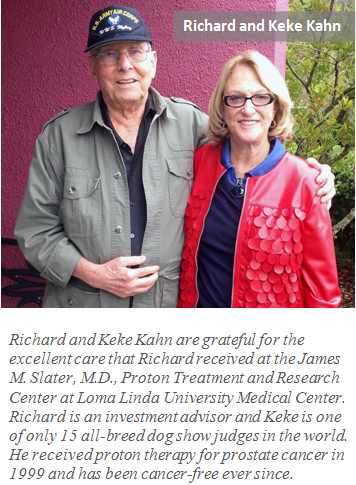
"The government taxes the individual every day of his working life," he observes. "I have no desire to let my estate be taxed after I'm not here."
"It's not expensive to set up a charitable foundation and you don't need billions of dollars to do it," Kahn adds.
Why did he choose to remember the James M. Slater, M.D., Proton Treatment and Research Center in his estate? He cites three reasons, all connected to benefits he received from proton therapy.
"First, as an engineer, I recognized early on that proton technology was superior to any other treatment available in 1999," Kahn explains. "It still is. Second, I hate the uncertainty and pain of surgery. Lastly, since my avocation is aviation, I must pass an annual physical exam to maintain my Commercial Pilot's license. At age 88, I remain Pilot-in-Command. If this case study attracts others to the Loma Linda proton center, I will have achieved my goal."
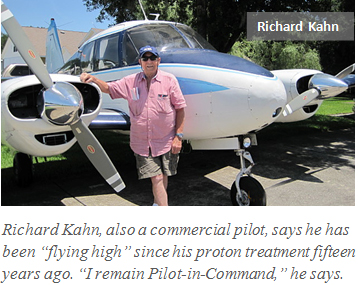
For information on how to support the James M. Slater, M.D. Proton Treatment and Research Center through an estate gift, contact Todd Mekelburg at the Office of Planned Giving by phone at 909-558-4553, visit the website at llulegacy.org or e-mail [email protected].
Matching Gift Promises to Double Yours
Don't forget: The founder of the Sequoia Foundation for Achievement in Culture and Education is encouraging fellow BOB members to match a $25,000 challenge grant. The foundation will match gifts of $1,000 or more to the Robert J. Marckini Chair, up to a total of $25,000, until December 31, 2014. Please consider taking this opportunity to double the impact of your gift!
If you are inspired to give or have questions about the various ways to support proton research efforts, please contact Aaron Laudenslager in the Office of Philanthropy at 909-558-3581 or [email protected].
You may also contribute by check. Just make your check out to "LLUMC Proton," specify Robert J. Marckini Chair in the memo, and mail it to: Loma Linda University Medical Center, Office of Philanthropy, P.O. Box 2000, Loma Linda, CA 92354.
Or, donate online. Specify Robert J. Marckini Chair under "Designations."
To learn about naming Loma Linda University Health in your will or trust, please contact the Office of Planned Giving at (909) 558-4553 or e-mail [email protected].
events
Recap: April Visit to Loma Linda
In April or May each year, people converge on Loma Linda from all corners of the globe for the annual Proton Charity Golf Tournament. Another small group of people visit at the same time to participate in the Proton Advisory Council which meets twice yearly at Loma Linda.
Proton Charity Golf Tournament
One hundred twenty-four golfers participated in this year's event. And as usual, the weather was perfect. The event was held at The Club at Morningside in Rancho Mirage, California, a spectacular private Jack Nicklaus signature golf course with lush, green fairways, beautiful landscapes, and breathtaking views of the San Bernardino, Santa Rosa, and San Jacinto Mountains. The Proton Charity Tournament was started 24 years ago by golf legend and TV personality, Ken Venturi, who hosted the event until his passing last year. It has raised more than $3.5 million, thus far, for proton therapy research.
After Ken's passing last year, John Cook, who used to be tournament advisor, stepped in to host the event. Assisting John is the new tournament advisor, Jamie Mulligan, a friend of John's, and a PGA teaching professional who has coached several touring pros, including John himself. What a great name for a golf pro … Mulligan!
John Cook conducted the golf clinic assisted by Jamie. In addition to learning how to hit the ball better, the audience was treated to plenty of laughs thanks to Jamie Mulligan's wit.
Dr. Jerry Slater, Chairman of the Department of Radiation Medicine at LLUMC, spoke at the awards luncheon after the tournament. With Ken Venturi's wife, Kathleen, in the audience, Dr. Slater acknowledged Ken's contributions over the years in support of LLUMC and proton research.
Rachelle Bussell, Senior Vice President for Advancement at Loma Linda University Health, also spoke at the awards ceremony luncheon. She brought greetings from LLUH President, Dr. Richard Hart, who was traveling in China. Rachelle also expressed appreciation to the audience for their support. "Your participation as a sponsor, player, volunteer, or member of the Morningside Board and staff is helping to change and save lives through the proton therapy research conducted by our clinicians and scientists. Thank you."
Prizes were awarded to the three teams with the lowest gross scores, and to the three teams with the lowest net scores. The team of Ed Rosenberg, John Ebin, Peter Shatz, and Bob Marckini won second place in the low gross category.
There was no winner of the "longest divot contest" this year, since Dr. Lynn Martell was unable to play due to knee replacement surgery. Lynn promises to be back next year to claim the title he has held for so many years.
Overall it was a fantastic day of golf, dining, and spending time with friends who have been participating in this event for many years.
We are reminded of something Ken Venturi often said when he addressed the group at the annual charity golf tournaments at Morningside:
"The world will not remember you for what you take from it"but for what you leave behind."
Ken Venturi gave his time and treasure to countless charities over the years. The $3.5 million Chair in his name, funding proton research at Loma Linda is only one of many causes he supported. Ken not only talked the talk, he walked the walk, and he will long be remembered for what he left behind.
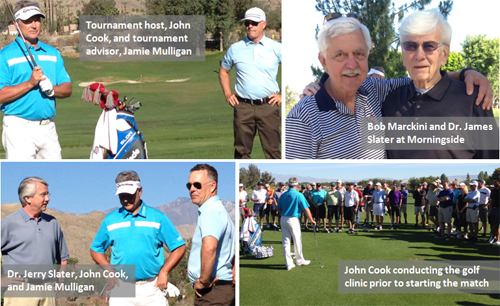
Advisory Council Meeting
About 16 BOB members serve on the Proton Advisory Council at Loma Linda. We meet twice yearly at Loma Linda. Our role is to give back by serving as proton ambassadors, advisors, and supporters of the institution that saved our lives and preserved the quality of our lives. Mostly we meet to develop strategies for raising funds for proton therapy research.
All council members contribute annually, and we have all placed LLUMC proton research in our estate plans. We also encourage others who have benefited from proton therapy to do the same.
The agenda was full for our April 29 meeting. One of the highlights was an update by Dr. Jerry Slater on a number of basic and clinical research projects including the prostate cancer treatment hypo-fractionation clinical trial, using protons instead of high-risk catheter ablation for treating atrial fibrillation, treating arteriovenous malformation in the brain, and most exciting, using protons to treat the source of neurogenic pain, something that will greatly benefit our injured service men and women returning from war zones with missing limbs and other serious injuries.
Wednesday Night Meeting and the 7,000th BOB Member
Dr. Lynn Martell and Carol Davis invited Bob Marckini to speak at the Wednesday night meeting on April 30. Bob used the occasion to present Charles Stohrer an award for being the 7,000th member of the "Majestic and Prestigious" Brotherhood of the Balloon. In case you're not sure, Charles is the very tall, good looking guy in the photo standing next to the old guy with the white hair.
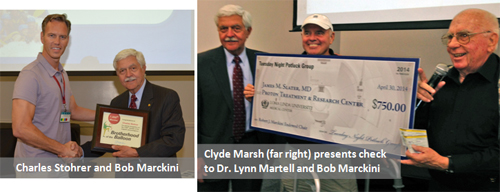
Also at the Wednesday meeting, BOB member, Clyde Marsh, long-time supporter of the BOB and LLUMC and coordinator of the Tuesday night potlucks, presented a check to Dr. Martell and Bob Marckini for $750 from the potluck group. The check will go to the R.J. Marckini Endowed Chair for proton therapy research.
health
"Sleep Problems Tied to Prostate Cancer Risk"

That's the title of an article on MedPage Today, which was based on a study reported in the May 2013 issue of Cancer, Epidemiology, Biomarkers, and Prevention. The report was based on a prospective study of 2,102 Icelandic men, which showed a 70 percent increased risk for prostate cancer among those who had problems falling asleep and a two-fold increased risk for those who had difficulty staying asleep, according to Lara Sigurdardóttir, MD, of the University of Iceland In Reykjavik.
Associations actually grew stronger when risks were limited to advanced prostate cancer. "If confirmed in future studies, the association between sleep disruption and prostate cancer risk may open new avenues for prevention," the authors said.
Read the entire MedPage article.
High Doses of Selenium Double Risk for Prostate Cancer
Alan Kristal, DrPH, associate program head of the Cancer Prevention Program at Fred Hutchinson Cancer Research Center in Seattle led a study that was published in the Journal of the National Cancer Institute. The study concluded that men who had moderate to high levels of the antioxidant selenium and took 200 mcg of selenium daily, doubled their prostate cancer risk. Researchers suggested that men should limit selenium intake to no more than the recommended dietary allowance of 55 mcg. Plant foods, such as vegetables, are the most common dietary sources of selenium.
New, Easier CPR Technique
What would you do if you came across someone who was unresponsive due to cardiac arrest? Obviously you should call 9-1-1. But do you know you would double the person's chance of survival if you performed Chest-Compression-Only CPR?
For every minute you delay, the survival rate drops by 10%. If you wait five minutes, there is less than a 50% chance of survival.
Cardiac Researchers at the University of Arizona have put out a new video on this technique, stating that mouth-to-mouth resuscitation is no longer necessary, and Chest-Compression-Only CPR is actually more effective.
With this procedure, you don't check for a pulse, you don't clear the airway, and you don't do mouth-to-mouth breathing. All you do is pump on the chest.
They claim it is easier to learn, easier to perform, and more effective than traditional CPR. You do not have to be certified to perform chest-compression-only CPR and Good Samaritan laws protect you from lawsuits.
Watch the six minute video here. Cardiac arrest is the number one killer in the U.S. If you learn this simple technique, you may someday save someone's life.
Chest-Compression-Only CPR is not for infants and small children or for someone who is drowning. In these cases, the preferred method is chest compression along with mouth-to-mouth ventilation.
Taking Aspirin Before Bed May Lower Heart Attack Risk
Researchers at Leiden University Medical Center in the Netherlands reported these findings at the American Heart Association's Scientific Sessions in Dallas, TX. Many take low dose aspirin daily to reduce their risk for heart attack. This study suggests that people consider taking it at night rather than in the morning. Nighttime aspirin consumption significantly reduces blood platelet activity in the morning. Platelet activity is associated with heart attacks and strokes, which occur most often in the morning.
All Skin Cancers Are Dangerous
With the warm weather here, more and more of us will be spending time outdoors in the sun. The Skin Cancer Foundation reminds us that every year nearly three million people in the US are diagnosed with basal cell carcinoma "BCC" and another 700,000 with squamous cell carcinoma "SCC". Neither of these is as serious as melanoma. But, BCC and SCC can spread, damaging tissue and bone, and become infected or cause disfigurement if untreated. Surgical removal may be needed.
Bob's book
Bob's book is currently in the #3 position on Amazon's list of 30,973 books on prostate cancer. There are new reader reviews every month and 188 in total"more than any other book in the top 50. Here are excerpts from what one reader recently had to say:

This book probably saved my life. "SEW
Bob Marckini's book probably saved my life. I learned about proton therapy from a friend, and did my due diligence learning about the treatment through Bob's book and the Internet. My urologist, however, had different plans for me, all of which only fell within the scope of his practice.
When I asked about proton therapy, he was dismissive"he told me it was only six sessions long, and had a very poor outcome compared to IMRT, and said, "I'll call Dr. X and set up an appointment for you." I told him about the length of treatment, the Bragg Peak, the outcomes percentage comparables, and the lack of side effects. Not only was he only mildly interested; he seemed annoyed that I had done my own research. In fact, I showed him an Excel spreadsheet I had prepared "I'm a former university technology dean and like Bob, a recovering geek" with the "normal" treatment options, the pros, the cons, and my views, all in columnar format. He was not impressed that I would consider going outside of his practice. Basically, I represented a revenue stream to him, not an aging and fairly apprehensive patient to whom he owed the very best in care. So I divorced him.
Bob's book provides a wonderful, supportive service to all of us. It is a truthful book that eases fears and makes me realize that soon I am going to be part of a whole community of smiling survivors through proton therapy. I'm going to live a long time because of the knowledge he selflessly gave me. Buy this book"it could save your life too.
Did you find Bob's book helpful?
Please help us to spread the word and educate others about proton therapy. If you found Bob's book to be helpful in making your proton treatment decision, please post a review on Amazon.
Once you are logged into your Amazon account, click here and click the "Create your own review" button. NOTE: Reviews can be just a few sentences"it only takes a few minutes. And, don't forget to rate the book from 1 to 5 stars!
Don't have an Amazon account? No problem. Sign up here"it's free.
Available in Amazon's Kindle format, Barnes & Noble's NOOK Book, and Apple iBook format
Buy the Kindle version now for $9.99.
Don't have a Kindle? No problem"just download the free Kindle reading software for your smart phone or tablet.
Buy the NOOK Book version now for $9.99.
Don’t have a NOOK? No problem. Just download the free NOOK reading app for your Android smart phone, tablet, or iDevice.
Buy the book from the iTunes store for $9.99 for your iPhone, iPad, or iPod Touch in iBook format.
The hard copy version of You Can Beat Prostate Cancer is available online at Amazon, Barnes & Noble and LuLu Press.
Proceeds from book sales are used to help fund BOB efforts and to support proton therapy research.
Ask about our bulk discount for hard copy books for anyone interested in spreading the word about proton therapy: [email protected]
odds & ends
One More Reason to Choose Proton
A recent Johns Hopkins Health Alert reported on a study involving 1,655 men with early-stage, localized prostate cancer who were treated with surgery or conventional radiation in the mid-1990s. The men were 55 to 74 years old at the time of treatment and were followed for 15 years. During that time they were asked questions about erectile dysfunction, urinary incontinence, and bowel urgency.
The Findings According to the Report
After five years, men who had surgery were significantly more likely to have erectile dysfunction and urinary incontinence, while men who received radiation therapy had higher rates of bowel urgency. But after 15 years, rates of these concerns were similar in both groups, and most of the men, regardless of treatment had developed erectile dysfunction.
So, the surgery group had high rates of urinary incontinence and erectile dysfunction, and the radiation group had high rates of bowel urgency. And eventually most in both groups had high rates of erectile dysfunction.
Compare these results to the results of the 2014 Proton Patient NAPT survey reported in last month's BOB Tales. In the NAPT survey, 3,800 men who were treated with protons over the past 24 years reported on their outcomes. Those patients who had proton only, i.e., no additional photon treatment or hormonal therapy"which would be comparable to the Johns Hopkins "early-stage localized cancer group""reported urinary, bowel, and sexual function scores comparable to men who never received any treatment for prostate cancer. Just one more reason to choose proton therapy for treating prostate cancer.
Why Do Boomers Need to Update Their Last Will and Testament?
BOB member, Ron Hendricks, is Director of Gift Planning for Trinity Western University in Washington State. He also serves on the Proton Advisory Council at Loma Linda. The following is from one of his recent weekly newsletters:
I sit at the kitchen table of many Baby Boomers "I am one myself". About half of them have written their Will when their children were young; the other half always meant to but just never got around to it. Which half do you fit into?
For those who have never written their will, I simply give assistance and direction to get them started. For those who have written their will, I will read through it with them to confirm that it still says what they want it to. While they generally do not need to have guardians for their children any longer most often they find out that their executor either has already passed away or is no longer the right person to execute their estate. A short visit with their attorney can either add an addendum for a few changes or can rewrite their simple will if they so desire.
This is also a great time to review their beneficiaries and consider adding an additional child named "Charity" to their family. This provides an opportunity for them to leave a portion of their estate to the ministry of their choice. While I never encourage families to disinherit their children I do encourage them to share their estate with charities and in particular with God's Kingdom.
BOB Comment: Why not consider including a gift to the R.J. Marckini Chair at Loma Linda in your estate plan? It's a great"and painless"way to support proton therapy research and say thank you to Loma Linda for the gift you have been given through proton therapy.
How to Block Unwanted Phone Calls
We are all plagued with unwanted phone calls including political calls, telemarketing calls, robocalls, and others. There are a few things you can do to minimize the number of these calls reaching you:
- Register your landlines and cell phone numbers with the Do Not Call Registry.
- Stop writing your phone number on forms and entering them into websites. Retail websites, charities, and political organizations often ask for phone numbers, but that doesn't mean you have to provide them.
- Sign up for Nomorobo if your telecom provider is eligible. This is a free service that recently won the top prize from the Federal Trade Commission for coming up with a technological solution to reduce the number of robocalls. Incoming calls are routed not just to your phone but also to Nomorobo's computers. These computers very quickly determine whether the call is from an automatic dialer and hang up on the caller after the first ring. Nomorobo does allow legitimate automated phone calls through, such as reminders about doctor and other appointments. Most Internet or cable-based telecom providers offer Nomorobo, but many cellular and traditional landline providers currently do not, though that could change if Nomorobo continues to gain in popularity. "Read more about Nomorobo in this USA Today article."
- Block calls from troublesome phone numbers. Most telecom providers allow their customers to block incoming calls from specific numbers. Contact your provider to see if this feature is available to you.
- Ask legitimate organizations to "put me on your do-not-call list." Pollsters, politicians, and companies that place unsolicited calls generally are required to maintain their own do-not-call lists.
Special Series: Messing with Your Mind
Here's the second in a series of five optical illusions that really mess with your mind.
Look at the picture below. How many: 7 or 10? Count at the top and then at the bottom.
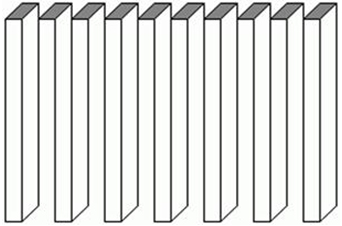

Did You Know?
Because it takes so long for their light to reach Earth, many of the stars you see at night are long gone.
Special Series: Did You Know THIS About Your Body?
The human body is a treasure trove of mysteries, one that still confounds doctors and scientists about the details of its working. It's not an overstatement to say that every part of your body is a miracle. Last month, we gave you five interesting facts about your body. Below is the last in a series that began ten months ago.
- Right-handed people live, on average, nine years longer than left-handed people do. This is largely due to the fact that a majority of the machines and tools we use on a daily basis are designed for those who are right handed, making them somewhat dangerous for lefties to use and resulting in thousands of accidents and deaths each year.
- Your ears secrete more earwax when you are afraid than when you aren't.
- Koalas and primates are the only animals with unique fingerprints.
- Humans are the only animals to produce emotional tears.
- The human heart creates enough pressure to squirt blood 30 feet in the air.
We hope you have enjoyed this special series on the human body.
Coming Next Month
Next month we will begin a series on the top 20 most common health questions. These include:
- Do you need sunscreen with more than 30 SPF?
- Nuts contain as much as 75% fat. Will they make you fat?
- Is drinking fruit juice as good for you as eating fruit?
- Do eggs raise cholesterol levels?
- Is it safe to microwave food in plastic containers?
On The Lighter Side
Last Month’s Brain Teaser: Clever Woman
Joan was sleeping in her apartment when suddenly a robber broke into her house. He asked her to stay quiet and started looting the cash and jewelry. Suddenly the landline phone started ringing. The robber pointed his gun at Joan and ordered her to pick up the phone across the room and talk without giving away the situation.
She picked up the phone and it happened to be her husband. She spoke, “Is it an emergency darling? Please give me a call when your flight lands. For dinner, I am preparing your favorite meal that will help you relieve the stress.” Then she hung up the phone.
Ten minutes later, the police arrived at the scene and caught the robber.
How did the police know about the robbery?
Solution: While talking with her husband on phone, Joan played with the mute button. She pressed mute on specific parts of her conversation in a manner that her husband heard only five words: “EMERGENCY … PLEASE … CALL … FOR … HELP.” So the husband immediately called the police.
We have a winner!
Norm Wakeen of Surprise, Arizona, was not only the only reader to submit the correct answer; he is a three-time winner of our brain teaser contests! And back in October, Norm was also the only reader to submit a correct answer to the brain teaser.
Typically when someone has already won a signed book, we send a signed copy of Bob’s book to the second person to guess correctly, but in this case, nobody else submitted the correct answer. So, we asked Norm what he wanted to do with his third signed book (in October, he gave the second one to his cousin who read it and underwent proton therapy).
“You can award the signed book to any member on my behalf, so they can do what I did—give it away to someone they think may benefit from it,” Norm said. He followed with, “It’s okay to mention me as a three-time winner. The rest of the guys better get with it!”
Norm was treated with proton therapy in 2007. Today, he’s enjoying retirement by playing golf and cooking for his wife, Catherine.
Congratulations again, Norm!
New Brain Teaser/Riddle: An Easy One
Answer next month: The first to send an e-mail to [email protected] with the correct answer will receive a signed copy of Bob's book. No cheating by using the Internet!
Old is Old … Not Stupid
A strong young man at a construction site was bragging that he could out-do anyone in a feat of strength. He made a special case of making fun of one of the older workmen.
After several minutes, the older worker had enough. "Why don't you put your money where your mouth is," he said to the young man. "I'll bet a week's wages that I can haul something in a wheelbarrow over to that building, that you won't be able to wheel back."
"You're on, old man," the braggart replied. "Let's see you do it." The old man reached out and grabbed the wheelbarrow by the handles. Then, nodding to the young man, he said, "All right young feller, get in."
Never mess with old people.
Quote of the Month
"If you are depressed, you are living in the past. If you are anxious, you are living in the future. If you are at peace, you are living in the present."
"Lao Tzu Harris
final thought
The Back Nine "Author Unknown"
You know, time has a way of moving quickly and catching you unaware of the passing years. It seems just yesterday that I was young, just married and embarking on my new life with my mate. Yet in a way, it seems like eons ago, and I wonder where all the years went. I know that I lived them all. I have glimpses of how it was back then and of all my hopes and dreams. But, here it is"the "back nine" of my life and it catches me by surprise. How did I get here so fast?
Where did the years go and where did my youth go? I remember vividly seeing older people through the years and thinking that those older people were years away from me and that I was only on the "first hole" and the "back nine" was so far off that I could not fathom it or imagine fully what it would be like.
But, here it is … my friends are retired and getting gray; they move slower; and I see an older person now. Some are in better and some worse shape than me, but I see the great change. Not like the ones that I remember who were young and vibrant … but like me, their age is beginning to show and we are now those older folks that we used to see and never thought we'd become. Each day now, I find that just getting a shower is a real target for the day! And taking a nap is not a treat anymore … it's mandatory! ‘Cause if I don't on my own free will, I just fall asleep where I sit!'
And so, now I enter into this new season of my life unprepared for all the aches and pains and the loss of strength and ability to go and do things that I wish I had done but never did. But, at least I know, that though I'm on the "back nine" and I'm not sure how long it will last, this I know for sure, that when it's over on this earth … it's over. A new adventure will begin!
Yes, I have regrets. There are things I wish I hadn't done … things I should have done … but indeed, there are many things I'm happy to have done. It's all in a lifetime. So, if you're not on the "back nine" yet … let me remind you, that it will be here faster than you think. So, whatever you would like to accomplish in your life please do it quickly. Don't put things off too long!
Life goes by quickly. So, do what you can today, as you can never be sure whether you're on the "back nine" or not!
You have no promise that you will see all the seasons of your life … so, live for today and say all the things that you want your loved ones to remember, and hope that they appreciate and love you for all the things that you have done for them in all the years past.
"Life" is a gift to you. The way you live your life is your gift to those who come after. Make it a fantastic one.
Low PSAs to all,
Bob Marckini and Deb Hickey
You can download this month's BOB Tales in PDF format to your computer by "right-clicking" ("control-clicking" on Mac) and going to the "Save Target As… " option on the menu that pops up.
NO MEDICAL ADVICE: Material appearing here represents opinions offered by non-medically-trained laypersons. Comments shown here should NEVER be interpreted as specific medical advice and must be used only as background information when consulting with a qualified medical professional.

